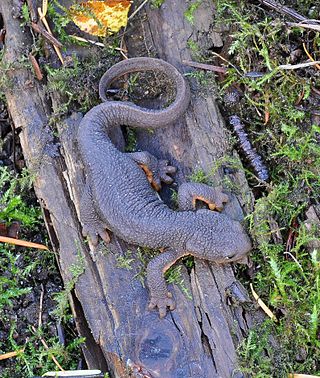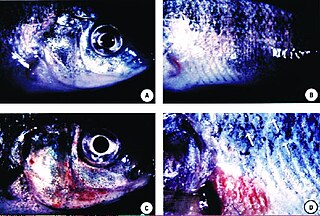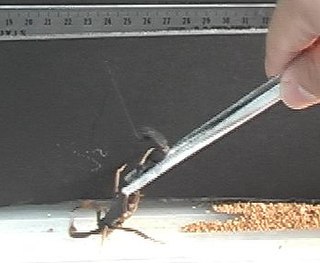
Tetraodontidae is a family of primarily marine and estuarine fish of the order Tetraodontiformes. The family includes many familiar species variously called pufferfish, puffers, balloonfish, blowfish, blowers, blowies, bubblefish, globefish, swellfish, toadfish, toadies, toadle, honey toads, sugar toads, and sea squab. They are morphologically similar to the closely related porcupinefish, which have large external spines.

A toxin is a naturally occurring organic poison produced by metabolic activities of living cells or organisms. They occur especially as proteins, often conjugated. The term was first used by organic chemist Ludwig Brieger (1849–1919) and is derived from the word "toxic".

Batrachotoxin (BTX) is an extremely potent cardiotoxic and neurotoxic steroidal alkaloid found in certain species of beetles, birds, and frogs. The name is from the Greek word βάτραχος, bátrachos, 'frog'. Structurally-related chemical compounds are often referred to collectively as batrachotoxins. In certain frogs, this alkaloid is present mostly on the skin. Such frogs are among those used for poisoning darts. Batrachotoxin binds to and irreversibly opens the sodium channels of nerve cells and prevents them from closing, resulting in paralysis and death. No antidote is known.

The Colorado River toad, also known as the Sonoran Desert toad, is a toad species found in northwestern Mexico and the southwestern United States. It is well known for its ability to exude toxins from glands within its skin that have psychoactive properties.

Ostraciidae or Ostraciontidae is a family of squared, bony fish belonging to the order Tetraodontiformes, closely related to the pufferfishes and filefishes. Fish in the family are known variously as boxfishes, cofferfishes, cowfishes and trunkfishes. It contains about 23 extant species in 6 extant genera.

The rough-skinned newt or roughskin newt is a North American newt known for the strong toxin exuded from its skin.
Prymnesium parvum is a species of haptophyte. The species is of concern because of its ability to produce the phycotoxin prymnesin. It is a flagellated alga that is normally found suspended in the water column. It was first identified in North America in 1985, but it is not known if it was introduced artificially or missed in previous surveys. Toxin production mainly kills fish and appears to have little effect on cattle or humans. This distinguishes it from a red tide, which is an algal bloom whose toxins lead to harmful effects in people. Although no harmful effects are known, it is recommended not to consume dead or dying fish exposed to a P. parvum bloom.

The longhorn cowfish, also called the horned boxfish, is a species of boxfish from the family Ostraciidae, recognizable by its long horns that protrude from the front of its head, rather like those of a cow or bull. They are a resident of the Indo-Pacific region and can grow up to 50 cm (20 in) long.

The yellow boxfish is a species of boxfish found in reefs throughout the Pacific Ocean and Indian Ocean as well as the southeastern Atlantic Ocean. Recorded occasionally since 2011 in the Levantine waters of the Mediterranean Sea which it likely entered via the Suez Canal, it is a species appreciated in the aquarium trade.

Pumiliotoxin 251D is a toxic organic compound. It is found in the skin of poison frogs from the genera Dendrobates, Epipedobates, Minyobates, and Phyllobates and toads from the genus Melanophryniscus. Its name comes from the pumiliotoxin family (PTXs) and its molecular mass of 251 daltons. When the toxin enters the bloodstream through cuts in the skin or by ingestion, it can cause hyperactivity, convulsions, cardiac arrest and ultimately death. It is especially toxic to arthropods, even at low concentrations.

Predatory dinoflagellates are predatory heterotrophic or mixotrophic alveolates that derive some or most of their nutrients from digesting other organisms. About one half of dinoflagellates lack photosynthetic pigments and specialize in consuming other eukaryotic cells, and even photosynthetic forms are often predatory.

The spotted trunkfish is a member of the family Ostraciidae. It lives in reefs throughout the Caribbean, as well as the southwestern Atlantic Ocean. It gets its name from the black spots on its whitish or yellow-golden body. In Caribbean countries, it is colloquially known as the boxfish, cow-fish or shellfish.
Microbial toxins are toxins produced by micro-organisms, including bacteria, fungi, protozoa, dinoflagellates, and viruses. Many microbial toxins promote infection and disease by directly damaging host tissues and by disabling the immune system. Endotoxins most commonly refer to the lipopolysaccharide (LPS) or lipooligosaccharide (LOS) that are in the outer plasma membrane of Gram-negative bacteria. The botulinum toxin, which is primarily produced by Clostridium botulinum and less frequently by other Clostridium species, is the most toxic substance known in the world. However, microbial toxins also have important uses in medical science and research. Currently, new methods of detecting bacterial toxins are being developed to better isolate and understand these toxins. Potential applications of toxin research include combating microbial virulence, the development of novel anticancer drugs and other medicines, and the use of toxins as tools in neurobiology and cellular biology.

Lactophrys triqueter also known as the smooth trunkfish, is a species of boxfish found on and near reefs in the Caribbean Sea, Gulf of Mexico and subtropical parts of the western Atlantic Ocean.
Ichthyotoxins are compounds which are either toxic to fish, or are toxins produced by fish. The former include the algae-produced euglenophycin and prymnesins, which can cause large-scale fish deaths. The latter includes ostracitoxin, produced by boxfish. Many toxin-producing algal species can be found both in marine and fresh water environments when the algae are in bloom. Ichthyotoxic poisoning in humans can cause symptoms ranging in severity dependent on how much toxin was consumed. The symptoms of an ichthyotoxin poisoning from fish venoms can include headache, vomiting, diarrhea, dizziness, and drop in blood pressure.
Prymnesin-2 is an organic compound that is secreted by the haptophyte Prymnesium parvum. It belongs to the prymnesin family and has potent hemolytic and ichthyotoxic properties. In a purified form it appears as a pale yellow solid. P. parvum is responsible for red harmful algal blooms worldwide, causing massive fish killings. When these algal blooms occur, this compound poses a threat to the local fishing industry. This is especially true for brackish water, as the compound can reach critical concentrations more easily.

Kambo, also known as vacina-do-sapo, or sapo, is the dried skin secretions of the giant leaf frog, a species of frog, used as a transdermal medicine; however, evidence for its effectiveness is limited.
Grammistins are peptide toxins synthesised by glands in the skin of soapfishes of the tribes Grammistini and Diploprionini which are both classified within the grouper subfamily Epinephelinae, a part of the family Serranidae. Grammistin has a hemolytic and ichthyotoxic action. The grammistins have secondary structures and biological effects comparable to other classes of peptide toxins, melittin from the bee stings and pardaxins which are secreted in the skin of two sole species. A similar toxin has been found to be secreted in the skin of some clingfishes.

Toxungen comprises a secretion or other body fluid of one or more biological toxins that is transferred by one animal to the external surface of another animal via a physical delivery mechanism. Toxungens can be delivered through spitting, spraying, or smearing. As one of three categories of biological toxins, toxungens can be distinguished from poisons, which are passively transferred via ingestion, inhalation, or absorption across the skin, and venoms, which are delivered through a wound generated by a bite, sting, or other such action. Toxungen use offers the evolutionary advantage of delivering toxins into the target's tissues without the need for physical contact.













